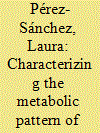|
|
|
Sort Order |
|
|
|
Items / Page
|
|
|
|
|
|
|
| Srl | Item |
| 1 |
ID:
162900


|
|
|
|
|
| Summary/Abstract |
The extreme degree of openness of contemporary urban systems with regard to both economy and population creates a serious challenge for the study of urban energy metabolism. A novel tool based on Multi-Scale Integrated Analysis of Societal and Ecosystem Metabolism (MuSIASEM) is proposed to overcome these challenges. It consists of an end-use matrix, a coherent multi-level integrated characterization of the uses of different forms of energy carriers (electricity, heat, fuels) for the various tasks performed in the city, including private and public mobility, tourism, commercial and residential activities. The end-use matrix integrates quantitative data referring to different dimensions (i.e. energy, human activity, land use, value added) and hierarchical (economic sectors and functional elements at lower levels) and spatial scales (i.e. individual buildings, neighborhoods, and the city as a whole). The end-use matrix provides information on both extensive (flows) and intensive variables (flow/fund ratios or benchmarks). Benchmarks are important for policy-making and allow a meaningful comparison of energy performance across hierarchical levels within the urban system, and among different urban systems. The approach is illustrated for Barcelona, a global city characterized by an important service sector.
|
|
|
|
|
|
|
|
|
|
|
|
|
|
|
|
| 2 |
ID:
098213


|
|
|
|
|
| Publication |
2010.
|
| Summary/Abstract |
This paper describes the methodology and data used to determine greenhouse gas (GHG) emissions attributable to ten cities or city-regions: Los Angeles County, Denver City and County, Greater Toronto, New York City, Greater London, Geneva Canton, Greater Prague, Barcelona, Cape Town and Bangkok. Equations for determining emissions are developed for contributions from: electricity; heating and industrial fuels; ground transportation fuels; air and marine fuels; industrial processes; and waste. Gasoline consumption is estimated using three approaches: from local fuel sales; by scaling from regional fuel sales; and from counts of vehicle kilometres travelled. A simplified version of an intergovernmental panel on climate change (IPCC) method for estimating the GHG emissions from landfill waste is applied. Three measures of overall emissions are suggested: (i) actual emissions within the boundary of the city; (ii) single process emissions (from a life-cycle perspective) associated with the city's metabolism; and (iii) life-cycle emissions associated with the city's metabolism. The results and analysis of the study will be published in a second paper.
|
|
|
|
|
|
|
|
|
|
|
|
|
|
|
|
| 3 |
ID:
098545


|
|
|
|
|
| Publication |
2010.
|
| Summary/Abstract |
This paper describes the methodology and data used to determine greenhouse gas (GHG) emissions attributable to ten cities or city-regions: Los Angeles County, Denver City and County, Greater Toronto, New York City, Greater London, Geneva Canton, Greater Prague, Barcelona, Cape Town and Bangkok. Equations for determining emissions are developed for contributions from: electricity; heating and industrial fuels; ground transportation fuels; air and marine fuels; industrial processes; and waste. Gasoline consumption is estimated using three approaches: from local fuel sales; by scaling from regional fuel sales; and from counts of vehicle kilometres travelled. A simplified version of an intergovernmental panel on climate change (IPCC) method for estimating the GHG emissions from landfill waste is applied. Three measures of overall emissions are suggested: (i) actual emissions within the boundary of the city; (ii) single process emissions (from a life-cycle perspective) associated with the city's metabolism; and (iii) life-cycle emissions associated with the city's metabolism. The results and analysis of the study will be published in a second paper.
|
|
|
|
|
|
|
|
|
|
|
|
|
|
|
|
| 4 |
ID:
149988


|
|
|
|
|
| Summary/Abstract |
Residential and commercial buildings comprise approximately forty percent of total energy consumption and carbon dioxide emissions in the U.S. Yet, while California spends $1.5 billion annually on energy efficiency programs, limited research has explored how building energy consumption varies within cities, including the social and structural factors that influence electricity and natural gas use. We present results from an analysis of aggregated account-level utility billing data for energy consumption across the over two million properties in Los Angeles County. Results show that consumption in L.A. County varies widely with geography, income, building characteristics, and climate. Several higher-income areas have greater total energy use per building even in cooler climates, while many lower-income regions rank higher for energy use per square-foot. Energy consumption also correlates with building age, which varies widely throughout the region. Our results demonstrate the many complex and interrelated factors that influence urban energy use. While billing data is critical for devising energy efficiency programs that actually realize estimated savings and promote more sustainable cities, opening access to such data presents significant challenges for protecting personal privacy. The presented approach is adaptable and scalable to cities seeking to develop data-driven policies to reduce building energy use.
|
|
|
|
|
|
|
|
|
|
|
|
|
|
|
|
|
|
|
|
|